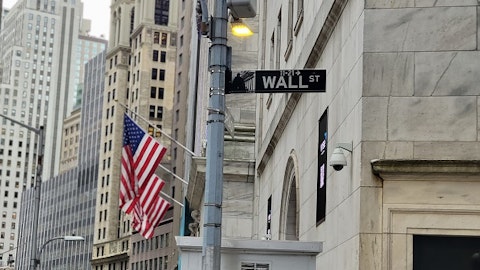BrightSpire Capital, Inc. (NYSE:BRSP) Q3 2023 Earnings Call Transcript October 31, 2023
Operator: Greetings, and welcome to the BrightSpire Capital, Inc. Third Quarter 2023 Earnings Conference Call. At this time, participants are in a listen-only mode. A question-and-answer session will follow the formal presentation. [Operator Instructions] As a reminder, this conference is being recorded. It is now my pleasure to introduce David Palame, General Counsel. Thank you, David. You may begin.
David Palame : Good morning, and welcome to BrightSpire Capital’s third quarter 2023 earnings conference call. We will refer to BrightSpire Capital as BrightSpire, BRSP, or the company throughout this call. Speaking on the call today are the company’s Chief Executive Officer, Mike Mazzei, President and Chief Operating Officer, Andy Witt; and Chief Financial Officer, Frank Saracino, Before I hand the call over, please note that on this call, certain information presented contains forward-looking statements. These statements, which are based on management’s current expectations, are subject to risks, uncertainties and assumptions. Potential risks and uncertainties could cause the company’s business and financial results to differ materially.
For a discussion of risks that could affect results, please see the Risk Factors section of our most recent 10-K and other risk factors and forward-looking statements in the company’s current and periodic reports filed with the SEC from time to time. All information discussed on this call is as of today, October 31, 2023, and the company does not intend and undertakes no duty to update for future events or circumstances. In addition, certain financial information presented on this call represents non-GAAP financial measures. The company’s earnings release and supplemental presentation, which was released yesterday and is available on the company’s website presents reconciliations to the appropriate GAAP measures and an explanation of why the company believes such non-GAAP financial measures are useful to investors.
Finally, during the call, management may refer to distributable earnings as DE. With that, I would now like to turn the call over to Mike.
Mike Mazzei : Thank you, David. Welcome to our third quarter earnings call, and thank you for joining us this morning. I’ll start by making some brief comments about the third quarter and then turn the call over to Andy. Everyone is well aware of the current geopolitical and economic issues, therefore, I’ll keep my macro remarks brief. Let’s first turn to BRSP’s results. For the third quarter, we reported GAAP net income of $12.4 million, or $0.09 per share. Distributable earnings of $31 million, or $0.24 per share, and adjusted distributable earnings of $35.8 million, or $0.28 per share. Our dividend coverage for the third quarter was 1.4 times. Our liquidity as of today stands at approximately $348 million. This is comprised of $183 million of current cash and $165 million under our credit facility.
During the quarter, our overall leverage stood at 1.9 times, flat with the second quarter. Quarter-over-quarter, our undepreciated book value increased by $0.02 to $11.55, largely driven by the 1.4 times dividend coverage this quarter. Turning briefly to the financial markets. Many believe the Fed is most likely done increasing the Fed funds rate. However, interest rates are becoming less anchored to the Fed’s tightening policy and increasingly tied to U.S. fiscal policy. If you look at the term premiums associated with longer-dated treasury yields, they are starting to become unhinged from the Fed’s monetary policies. The U.S. Treasury market is now becoming more preoccupied with Washington’s out-of-control deficit spending. This has led to the federal debt increasing by $600 billion in one month, bringing it to nearly $34 trillion.
The deficit spending is another reason why inflation has been very difficult to obtain. With the old long bond trading below a $1 price of $50, this will mark the first time that the US treasuries have had three consecutive years of losses. Today’s treasury bond issuance calendar is now larger than ever. Therefore, it makes sense that interest rates have been very volatile. The 10-year treasury yield has had intraday moves as much as 15 basis points and hit 5% just two weeks ago. Should that yield stick above 5%, that could be the threshold for a risk-off environment. But against this context, BRSP will continue to proactively manage our loan portfolio and look to maintain our cash liquidity as we navigate through these circumstances. In fact, I would now like to turn the call over to our President, Andy Witt.
Andy?
Andy Witt: Thank you, Mike, and good morning, everyone. Throughout the third quarter, the BrightSpire team has remained steadfast and our focus on proactive asset and portfolio management. During the third quarter, we received $58 million in repayments across two investments consistent with expectations, as repayment volume has been relatively muted. Year-to-date, we have received approximately $321 million in loan repayments. Looking ahead to the fourth quarter, we anticipate repayments to remain relatively low. Overall, our weighted average risk ranking increased slightly from 3.1 last quarter to 3.2 in the third quarter with 82% of our loans risk range three or better. Our weighted average risk ranking for the four prior quarters has remained relatively consistent at 3.2. We now turn to our watchlist update.
Sequentially, the number of watchlist loans increased by NAV 3. We had one loan upgraded off the watchlist for $28 million and one loan was removed, as we took ownership of the property underlying the Oakland office loan. Five loans were downgraded to a risk ranking of four, totaling $145 million. The loans that were downgraded were as a result of properties falling meaningfully behind on their business plans and where the borrower may not be in a position to support the asset. In addition, one loan was downgraded from a risk ranking four to five. The multifamily property collateralizing this loan has faced operational challenges, despite the borrowers’ recent efforts to raise additional equity for debt service and capital expenditures. It now appears they are unable to secure the incremental funds needed to execute the remainder of the business plan.

A Real Estate Investment Trust (REIT) property manager inspecting a newly acquired apartment complex.
However, as of today, this loan remains current and performing. Additional details regarding this quarter’s watchlist are included in our supplement. In terms of specific loan updates, we anticipate taking ownership of the Washington D.C. risk rank five office loan asset during the fourth quarter. Once we take control of the property, we expect to commence the sales marketing process. Our current carrying value is $20 million. With respect to the San Jose hotel property, we previously noted that a sales process was underway for the hotel Annex tower comprised of 264 rooms. The borrower anticipates the sale and corresponding partial pay down of our loan to occur in the fourth quarter. The loan remains risk ranked four. We will continue to maintain the current ranking on the remainder of the loan until we see a clear path to resolution.
This loan financing advance rate is less than 50%. As of September 30, 2023, excluding cash and net assets on the balance sheet, the portfolio is comprised of 92 investments with an aggregate carrying value of $3.1 billion and the net carrying value of $874 million or 80% of the total investment portfolio. The average loan size is $34 million. Our weighted average risk ranking is 3.2 and the loan portfolio has minimal future funding obligations, which stand at $200 million or 6% of outstanding commitments. First mortgage loans constitute 97% of our loan portfolio, of which 100% are floating rate, and all of which have interest rate caps. The multifamily portion of our portfolio remains our largest segment with 53 loans representing 52% of the loan portfolio or $1.6 billion of aggregate carrying value.
Office comprises 32% of the loan portfolio, consisting of $1 billion of aggregate carrying value across 30 loans with an average loan balance of $34 million. The remainder of our loan portfolio is comprised of 9% hospitality with industrial mixed-use collateral making up the remainder. With that, I will turn the call over to Frank Saracino, our Chief Financial Officer, to elaborate on the third quarter results. Frank?
Frank Saracino: Thank you, Andy, and good morning, everyone. Before discussing our third quarter results, I want to mention that our third quarter 2023 supplemental financial report is available on the Investor Relations section of our website. As Mike mentioned, for the third quarter, we reported adjusted DE of $35.8 million or $0.28 per share. Third quarter DE was $31 million or $0.24 per share. DE includes a specific reserve on one loan of approximately $5 million. Additionally, for the third quarter, we reported total company GAAP net income attributable to common stockholders of $12.4 million or $0.09 per share. Quarter-over-quarter, total company GAAP net book value decreased one-half of 1% from $10.16 per share to $10.11 per share.
However, undepreciated book value increased from $11.53 to $11.55 per share. The increase is a result of adjusted DE in excess of dividends acquired; partially offset by increases in our CECL reserves. The third quarter change in adjusted DE of $0.28 versus this $0.25 recorded in the second quarter was driven by the impact of rising interest rates and income from our operating real estate portfolio. Turning to our dividend. For the third quarter, we declared a dividend of $0.20 per share, in line with the second quarter. Our dividend remains well covered at 1.4 times. Looking at reserves. Our specific CECL reserves decreased to $35 million from $55 million, decrease was driven by the charge-off of the Milpitas, California mezz B note and are taking ownership of the property underlying the Oakland office loan.
This was offset by a specific reserve increase of approximately $5 million on the Washington, DC office loan. As Andy mentioned in his comments, we expect to take control of the Washington, DC office asset in short order. Finally, no specific reserve was required on the multifamily loan downgraded to a five. Our general CECL provision stands at $55 million, an increase of $3 million from the prior quarter. The increase in the general CECL was driven by economic conditions as well as specific inputs on certain office and multifamily properties. The combination of asset-specific and general CECL reserves at third quarter end was $90 million or 268 basis points on the total loan commitments, an overall decrease from $107 million or 311 basis points from the last quarter.
As a reminder, these are point-in-time assessments that we evaluate each quarter. Looking at watchlist highlights. Our two risk ranked 5 loans represent approximately 2% of the total loan portfolio carrying value. 10 loans equating to 16% of the total loan portfolio carrying value of risk rank 4. While over strength for loans are current performing loans, we see potential for increased risk and accordingly are monitoring these investments and working with sponsors to ensure the best possible outcomes. Moving to our balance sheet. Our total at share undepreciated assets stood at approximately $4.5 billion as of September 30th, 2023, steady with last quarter. Our corporate leverage levels remain at the low end of the sector. Our debt-to-assets ratio is 63% and our debt-to-equity ratio was 1.9 times, flat quarter-over-quarter.
We have no corporate debt or final facility maturities due until the second quarter of 2026. That concludes our prepared remarks. And with that, let’s open it up for questions. Operator?
See also 25 Least Forested Countries in Europe and 25 Least Racist States in the US.
Q&A Session
Follow Brightspire Capital Inc.
Follow Brightspire Capital Inc.
Operator: Thank you. Ladies and gentlemen, at this time, we will be conducting a question-and-answer session. [Operator Instructions] Our first question comes from the line of Sarah Barcomb with BTIG. Please proceed with your question.
Sarah Barcomb: Hey everyone. Thanks for taking the question. So, you discussed in the prepared remarks, the decision to downgrade some of those multifamily loans I’m just curious what the debt yield is on those roughly? And were there any modifications on those agreements during the quarter?
Mike Mazzei: Hey Sarah, how are you? Thanks. First of all, all those loans are current pay right now. And we’ve had, I think, most of them an indication from the borrower that they’re going to continue to support the asset. In fact, in one case, we have preferred equity that’s stepping in as well, supporting the assets. So, all of those loans are current. I think where we have an issue is that there is some execution issues at the property — property level and so in an abundance of caution, we’ve downgraded the loans. I think we’ve commented before that our biggest concern is going from a 3 to 5 where there is a default on a loan. And while that could happen, and anyone could be surprised, we want to demonstrate to the market that we’re earning on the side of being conservative.
So, those properties, we’re expecting new equity to come in. They fell behind on their business plans, some of them fell behind in their occupancies. But everything we’re hearing from the borrower in one case, the preferred equity is that they are going to step in. And as I said, all those loans are current. We had one loan that was a risk rated 4 that we upgraded to a 3 because the occupancy picked up dramatically over the quarter. And the loan that we downgraded, the multifamily loan that we downgraded to a five, that borrower, in fact, raised equity very recently, but there are real execution issues at the property. So the comment on the debt yield really is there was a real execution in terms of bad debt and turning around the units for refurbishment.
And so at this point, despite the fact that the borrower raised equity and the fact the loan is still current, we downgraded the loan because we’re going to plan on taking action around that asset. So really regarding the debt yields, all these properties are transitioned and the issue has been execution at the property level. But as I said, every indication we have at this point, even with the downgraded loans is that the borrowers or in this one case, the preferred equity are going to support the asset and get it back on track.
Sarah Barcomb: Okay. Great. Maybe just switching gears to office for a second. It appears the specific CECL reserve on the five-rated DC assets increased during the quarter and you’re now anticipating taking title. Could we see a charge-off in excess of that specific reserve taken in Q3 during Q4 results? Just trying to see how that will shake out in the model. And then what’s the occupancy on that building, if you have it?
Mike Mazzei: Well, first, let me tell you that we expect to foreclose on that building in November. And it doesn’t matter what the occupancy is because that building, we believe, needs to be converted to residential based on where it’s located and based on what’s going on in the DC office market. There is occupancy now there that covers expense — the leases are all very, very short. So one like other office properties where one of the issues with conversion is simply the rent roll that — the rent roll doesn’t allow it. So we think this is going to be a conversion and the markdown that we took is in anticipation of that. And since we really value the loan, a little ways back what’s happened, there’s final market for construction loans, and so we effectively marked the loan at what we think is pretty close to certainly land value on a square footage basis for office and close to land value for square footage basis on SAR for resi conversion.




